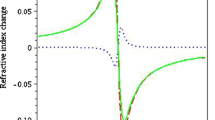Abstract
We have theoretically investigated second-harmonic generation (SHG) of spherical quantum dots with inversely quadratic Hellmann potential under the influence of hydrostatic pressure and temperature in the reported work. The Schrödinger equation which from the definition is solved using Nikiforov–Uvarov (N–U) method, and then energy level and wave function are derived. The compact density matrix method and iterative method are used to calculate the nonlinear optical SHG coefficient. The numerical results show that under different constraint parameters, the resonance peak of SHG coefficient moves to high energy or low energy, that is, redshift or blueshift. In addition, the peak of SHG coefficient will increase or decrease with the change of parameters.







Similar content being viewed by others
References
N Aghoutane, M El-Yadri, A El Aouami, E Feddi, F Dujardin, M El Haouari and H V Phuc Appl. Phys. A 125 1 (2019)
J T Tomaino, A D Jameson, Y S Lee, J P Prineas, J T Steiner, M Kira and S W Koch Solid State Electron. 54 1125 (2010)
Y Y Chen, X L Feng and C P Liu Phys. Rev. Lett. 117 023901 (2016)
M Servatkhah, R Khordad and A Firoozi Eur. Phys. J. B 93 1 (2020)
C J Zhang Phys. Lett. A 383 125983 (2019)
G Rezaei Curr. Appl. Phys. 11 176 (2011)
Z H Zhang, Y S Shi and J H Yuan Commun. Theor. Phys. 74 065502 (2022)
M Kria, M Farkous, V Prasad, F Dujardin, L M Pérez, D Laroze and E Feddi Curr. Appl. Phys. 25 1 (2021)
S Panda, T Das and B K Panda Superlattice. Microst. 135 106238 (2019)
S Pal, M Ghosh and C A Duque Philos. Mag. 99 2457 (2019)
Y B Yu Appl. Mech. Mater. 389 1075 (2013)
K Fellaoui Indian J. Phys. 93 1353 (2019)
S Sakiroglu, D Gul Kilic, U Yesilgul, F Ungan, E Kasapoglu, H Sari and I Sokmen Phys. B 539 101 (2018)
Q Zhao, S Aqiqi, J F You, M Kria and K X Guo Phys. E Low Dimens. Syst. Nanost. 115 113707 (2020)
S X Mo, K X Guo, G H Liu, X B He, J Y Lan and Z P Zhou Thin Solid Films 710 138236 (2020)
R Khordad Indian J. Phys. 86 513 (2012)
L Stevanović Opt. Mater. 91 62 (2019)
M Kria, M El-Yadri, N Aghoutane and L M Pérez J. Phys. 66 444 (2020)
X C Li, C B Ye, J Gao and B Wang Chin. Phys. B 29 087302 (2020)
P Hashemi, M Servatkhah and R Pourmand Opt. Quant. Electron. 53 1 (2021)
L C Zhang, X C Li, X G Liu and Z R Li Phys. B 618 413197 (2021)
N D Hien, C A Duque, E Feddi, N V Hieu, H D Trien, L T Phuong and H V Phuc Thin Solid Films 682 10 (2019)
B I Ita and A I Ikeuba J. At. Mol. Phys. 2013 1 (2013)
L Máthé, C P Onyenegecha, A A Farcaş and L M Pioraş-Ţimbolmaş Phys. Lett. A 397 127262 (2021)
B I Ita J. Theor. Phys. Cryptogr. 4 2322 (2013)
I B Okon and A D Antia Phys Sci. Int. J. 24 61 (2020)
C Tezcan and R Sever Int. J. Theor. Phys. 48 337 (2009)
R L Restrepo, E Kasapoglu, S Sakiroglu, F Ungan, A L Morales and C A Duque Infrared Phys. Tech. 85 147 (2017)
C M Duque, M E Mora-Ramos and C A Duque J. Lumin. 138 53 (2013)
H Bahramiyan Indian J. Phys. 94 789 (2020)
L V Tung, P T Vinh, L Dinh and H V Phuc Int. J. Mod. Phys. B 32 1850162 (2018)
U Yesilgul, H Sari, F Ungan, J C Martínez-Orozco, R L Restrepo, M E Mora-Ramos and I Sökmen Chem. Phys. 485 81 (2017)
Acknowledgements
Project supported by Support National Natural Science Foundation of China (Grant Nos. 52174161, 12174161, 51702003, 61775087, and 11674312) and Innovation Fund for Postgraduate in Anhui University of Science and Technology (No. 2022CX2132).
Author information
Authors and Affiliations
Corresponding author
Additional information
Publisher's Note
Springer Nature remains neutral with regard to jurisdictional claims in published maps and institutional affiliations.
Appendix: Overview of Nikiforov–Uvarov (N–U) method
Appendix: Overview of Nikiforov–Uvarov (N–U) method
The N–U method is mainly used to solve particular forms of second-order differential equations. This Schrödinger equation conforms to the following format
the above formula can be transformed into the following hypergeometric equation through coordinate transformation
where \(\sigma \left( s \right)\)and \(\overline{\sigma }\left( s \right)\)are second-degree polynomials, \(\overline{\tau }\left( s \right)\)is a first-degree polynomial, and \(\psi \left( s \right)\)can be written as
where \(\varphi \left( s \right)\)denotes the derivative of logarithm [22], whose form is
where \(\xi \left( s \right)\) represents first-order polynomials.
Simultaneous Eqs. (2) and (3), we can get the hypergeometric equation
In Eq. (5), when the condition that n is a constant value is satisfied, we can gain hypergeometric-type functions according to the Rodrigue relation
among \(C_{n}\) is normalized constant, \(\rho_{n} \left( s \right)\) expresses weight function and must meet the following conditions
The parameter b and function \(\xi \left( s \right)\) have the following relationship
when the discriminant is zero, we can obtain a new eigenequation
Rights and permissions
Springer Nature or its licensor (e.g. a society or other partner) holds exclusive rights to this article under a publishing agreement with the author(s) or other rightsholder(s); author self-archiving of the accepted manuscript version of this article is solely governed by the terms of such publishing agreement and applicable law.
About this article
Cite this article
Chang, C., Li, X., Duan, Y. et al. Effects of hydrostatic pressure and temperature on the second-harmonic generation of spherical quantum dots with inversely quadratic Hellmann potential. Indian J Phys 97, 1465–1471 (2023). https://doi.org/10.1007/s12648-022-02507-9
Received:
Accepted:
Published:
Issue Date:
DOI: https://doi.org/10.1007/s12648-022-02507-9




